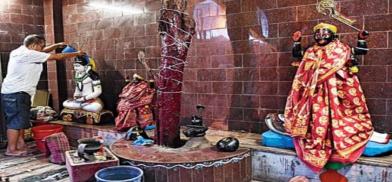The little-known Chinese Kali temple in Kolkata - a testament to cross-cultural bonding in challenging times
Kolkata is home to more than 2,000 Chinese, a close-knit community that has made the city its home for decades and arduously hung on to their culture and heritage through generations while making their mark in the tannery, beauty salons, shoe and restaurant businesses in the teeming eastern metropolis

Kolkata is home to more than 2,000 Chinese, a close-knit community that has made the city its home for decades and arduously hung on to their culture and heritage through generations while making their mark in the tannery, beauty salons, shoe and restaurant businesses in the teeming eastern metropolis. However, through the years of cross-cultural pollination, many have imbibed many of the local habits, customs and even religious beliefs, so much so there stands a Chinese Kali temple in Kolkata, a city where Goddess Kali is one of the presiding deities.
Located at Tangra, India’s only Chinatown and dotted with many exotic Chinese eateries that provide the only bright lights in a dinghy lane, the temple acts as a bridge between the fast dwindling Chinese community and the locals, who otherwise hardly rub shoulders with each other.
Alongside the Chinese community members, the local Bengalis also visit the temple regularly to pray before the goddess who is presented with unlikely offerings of Chinese dishes like noodles and chop suey as 'prasad' (food offered to Hindu gods as part of religious rituals).
A Bengali priest comes every morning and evening for performing the religious rituals, says Ison Chen, a Buddhist Chinese, who has been the in-charge of the temple for two decades.
The temple came up in 1998, with funds generously donated by both the Chinese and the Bengalis, out of two granite stones kept under a tree that used to be worshipped by the local Hindus for over half a century.
There hangs a beautiful tale, part or whole of which could be true or a myth.
The story goes that a ten-year-old Chinese boy had fallen grievously ill and got cured only after his parents laid him near the tree and prayed for several nights seeking divine intervention for his recovery.
As the boy recovered, the place became a pilgrimage of sorts for the Chinese community members – most of them Buddhists and some Christians - who joined their Bengali brethren in constructing the temple, said Chen.
The two black stones are still there in the granite walled temple, which has two idols of the goddess Kali. Another Hindu god Lord Shiva – consort of the goddess – can also be worshipped there.
The rituals are a melting pot of Hindu and Chinese traditions.
While the hymns and the proceedings are conducted as per Hindu beliefs, the devout light tall candles and Chinese incense sticks.
In another Chinese custom, handmade paper is burnt to keep away evil spirits.
India has been hosting the Chinese from the time of scholars Fa Hien (4th century) and Huen Tsang (7th century). But it was only around the 1700s that the Chinese began settling n and around Kolkata in good numbers.
The first Chinese settlers in Kolkata were runaway sailors and indentured servants, who did odd jobs while waiting for ships to take them away, and gradually made Kolkata their home by abandoning their seafaring ways.
Tangra developed as Chinatown with the Chinese setting up tanneries after 1910. The Chinese population increased through the 1920 and 1930s, as many men got jobs in the tea gardens and brought in their families. But over the years, their numbers have sharply diminished, as the young have gone away to look for better pastures in the West, and only the older generation is now left to carry on a unique cultural legacy that might die a slow death.
(SAM)








Post a Comment